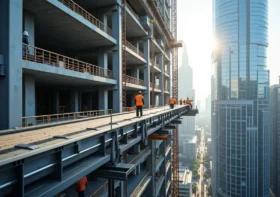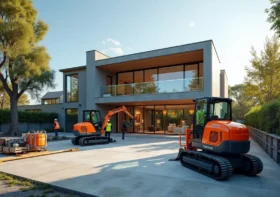Rooftop Gardens: The Perfect Urban Escape

An increasingly popular trend, rooftop gardens are transforming urban spaces into lush, green sanctuaries. These elevated terraces offer a blissful escape from city life, providing a refreshing breather in some of the most unexpected locales. Rooftop gardens are set to achieve even broader acclaim as cities grow denser and greener solutions become mandatory.
Contents
The Undeniable Charm of Rooftop Gardens
Rooftop gardens aren’t just delightful; they’re dramatically impactful. Picture thriving patches of greenery absorbing sunlight, contrasted against a backdrop of towering skyscrapers. This isn’t merely an aesthetic layer to urban spaces; it’s a game-changer.
The environmental benefits are extensive, with these gardens significantly reducing the urban heat island effect by cooling surrounding areas. This alone positions rooftop gardens as imperative features in sustainable urban development.
Environmental Impact: A Greener City
Besides moderating temperatures, rooftop gardens play a commendable role in air purification. Plants absorb pollutants, producing oxygen to improve urban air quality. Moreover, these gardens are known for their exceptional stormwater management, absorbing rainfall that would otherwise overflow and weigh down local drainage systems. This alleviates the risk of waterlogging while promoting efficient water use.
In addition to their water management roles, rooftop gardens provide habitats for urban wildlife, offering refuge and resources to birds, insects, and other small animals.
These spaces can create biodiversity hotspots that encourage animal and plant species that might otherwise be lost in city environments. As cities become more populated, providing these necessary spaces becomes an important aspect of urban planning, further establishing urban greenery as invaluable.
When considering the benefits of rooftop gardens, those planning to build or renovate their buildings must assess the structural viability of their roofs. For instance, opting for a flat roof in Phoenix could enhance the potential for an effective green space, as these types of roofs can accommodate the soil and plants necessary to create a flourishing habitat.
Food Security in Urban Areas
Beyond their aesthetic allure, rooftop gardens present a practical solution to issues of food scarcity and rising food costs. Urban farming on rooftops is becoming increasingly common as it allows residents to cultivate fresh produce right on their premises.
Imagine harvesting plump tomatoes and crisp lettuces from a rooftop just a few floors above your living room. Such initiatives contribute positively to a city’s food security while reducing the carbon footprint associated with transporting produce.
Not only do rooftop gardens reduce reliance on imported food sources, but they also encourage inhabitants to explore healthier lifestyles through plant-based diets and home-grown meals.
They provide an opportunity for people, especially those in food deserts, to access fresh produce that may otherwise be unavailable or too costly. By expanding urban agricultural projects, cities can promote healthier and more self-sufficient communities, linking urban gardening to wider social benefits.
Rooftop Gardens as Social Spaces
The appeal of rooftop gardens extends beyond environmental gains. They serve as perfect urban havens where residents and office workers can unwind for a bit, relax, and socialize. Having a green space to escape to during lunch breaks or weekend hangouts is invaluable. On top of that, these gardens can foster community as neighborhoods collaborate to create shared gardens, bringing people together around a shared purpose.
Creating community events in rooftop gardens can enhance social bonds, bringing people together through gardening workshops, sustainability seminars, and social gatherings. These events provide an opportunity to connect with neighbors and cultivate a shared understanding of sustainable practices. By involving the community, rooftop gardens become a space where collective learning and collaboration thrive, significantly enriching the urban living experience.
The Future of Urban Aesthetics
As cities grapple with expanding populations and limited space, rooftop gardens are surfing the wave of architectural redefinition. Multi-use buildings designed to incorporate green terraces are appearing more frequently, representing a step towards harmonious balance between nature and infrastructure. By harnessing building designs’ vertical potential, urban planners and architects can craft cities that thrive environmentally and socially.
As more architects engage with green building designs, the criteria for urban beauty are shifting. Aesthetic expectations are rich with sustainable elements, raising the standards for how we envision and construct cityscapes.
With the increasing integration of plants and contemporary building materials, the aesthetic framework of cities evolves to reflect a balance of nature and urban living. Roof gardens are poised to be symbols of this progressive vision, presenting a compelling blueprint for future urbanization.
Key Challenges and Potential Solutions
While the benefits are abundant, rooftop gardens also pose structural and logistical challenges. Weight load capacities, waterproofing measures, and municipal regulations often present barriers to implementation. However, innovative solutions are emerging, allowing for lightweight garden systems and adaptable green roof installations. Inspired by the soaring interest in rooftop green spaces, builders and designers continue to push the boundaries, enabling urban environments to optimize their resources more efficiently.
To overcome these hurdles, new construction materials and design strategies are being implemented, ensuring that rooftop gardens can complement existing architectural structures safely. Collaborations between city planners, engineers, and environmental specialists can help address these barriers, providing customized solutions adaptable to diverse urban landscapes. This holistic approach aids in making green roofs more accessible and widely adopted across urban environments.
Conclusion
Rooftop gardens are a whisper of nature amidst urban environments, promising and delivering far more than visual appeal. They function as climate agents, social hubs, food suppliers, and urban decoratives—each reinforcing the other.
Cities embracing rooftop gardens are set to lead the way in merging nature with urbanity, creating environments that nurture both planet and people. Consider this: the next time you find yourself gazing skyward, realize that above those walls and beneath the skyline, there’s a garden waiting to be discovered.



